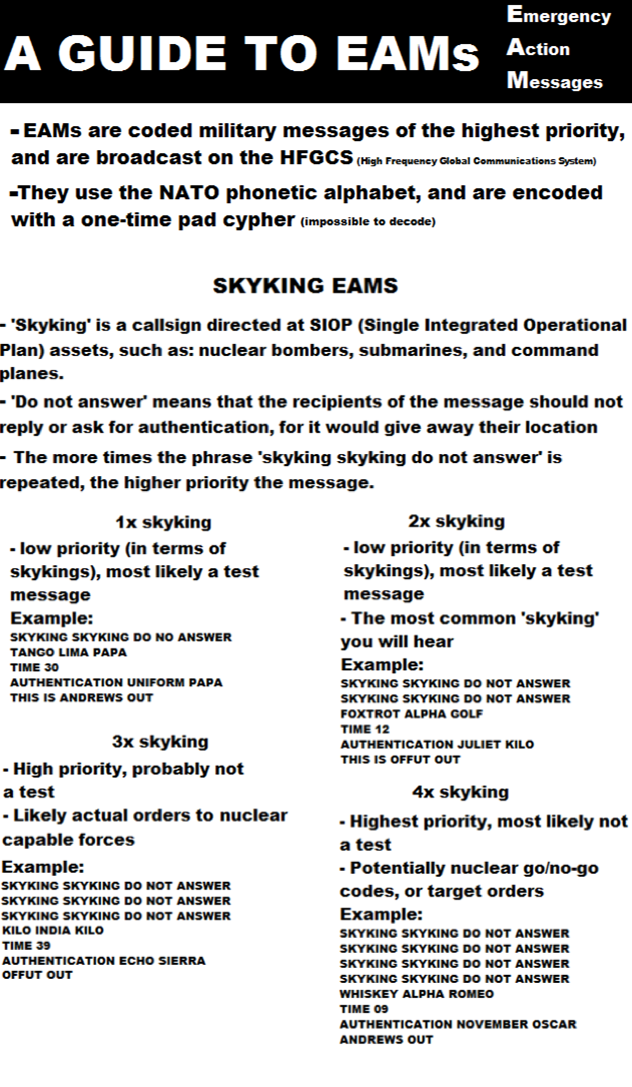
General Curtis LeMay, known in the Air Force as father of USAF Strategic Air Command

General Jack D. Ripper, “fictional” character, Commie-hater, and preserver of “precious bodily fluids”
 Map showing locations of High Frequency Global Communication System transmitter stations
Map showing locations of High Frequency Global Communication System transmitter stations
Pamphlet explaining Skyking EAMs to USAF radio operators
 PLZT (Polarized Lead Zirconium Titanate) flash blindness goggles protect B-52H and B-2A pilots from temporary blindness due to a nuclear detonation flash.
PLZT (Polarized Lead Zirconium Titanate) flash blindness goggles protect B-52H and B-2A pilots from temporary blindness due to a nuclear detonation flash.Skying, Skying, do not answer…
The USAF High Frequency Global Communication System (HFGS) is a broadcast and receiving network comprised of 14 high frequency radio command and control centers around the world. One purpose of the High Frequency Global Communication System is to communicate encrypted orders to USAF flight teams in the case of the enactment of the Single Integrated Operational Plan (SIOP). The SIOP, developed by the USAF Strategic Air Command (SAC) under the leadership of General Curtis LeMay, was the United States’ plan for nuclear war from 1961-2003.
Information is relayed to flight crews in the form of and Emergency Action Message (EAM). An EAM is a pre-formatted message that directs nuclear capable forces to do… something. The messages are simply a series of letters, relayed in NATO phonetics, and encrypted with a one-time cypher. The receiver would need a code book (by varying reports refreshed daily, weekly, or monthly and inches thick) to identify the key and decrypt the message.
The specific EAMs we will be listening to on this show are called Skyking messages.
The format of these messages is always the same. Salutation, trigraph, timestamp, authentication, and then a series of letters comprising the coded message.
For example:
Skyking, Skyking, do not answer.
Message follows.
Papa Tango Three. Time three five. Authentication Whiskey November. Quebec, Juliett, Sierra, Zulu, Foxtrot, X-Ray, Echo…
The content of these cryptic missives will likely remain so, and the content of tonight’s show will likely create more questions than answers. But there are some knowns we can consider. ‘Skyking’ is the callsign for all active units in the SIOP. Probably meaning squadrons of B-52s. ‘Do not answer’ instructs flight crews not to respond and give away their position. So these messages are tests of the US nuclear defense system, likely providing target information to aircrews (let’s think of them as nuclear delivery systems) already aloft, else they would not need to use HF radio to communicate.
The thing that makes these Skyking messages a matter of intense speculation in the community of radio monitors is that they are still being broadcast daily. The SIOP terminated in 2003. The Cold War is long over, the US has developed a diplomatic strategy to deal with nuclear proliferation, and national security fears are focused upon the threats created by rouge states and terrorism.
The US does not still have nuclear armed bombers aloft at all times, waiting for the radio message that might end the world, does it? Let’s hope not. Though, after pausing to think for a moment about what else the US military might be doing with a high-frequency radio command and control structure set up to withstand an EMP pulse or nuclear first strike, maybe it’s best to stop worrying and learn to love the bomb.
Background courtesy of the National Security Archives at George Washington University, the Monitoring Times , and my father’s anecdotes of his time with the 117th Air Refueling Squadron.
Broadcast date: March 22nd 2016
KCHUNG Los Angeles 1630AM
The USAF High Frequency Global Communication System (HFGS) is a broadcast and receiving network comprised of 14 high frequency radio command and control centers around the world. One purpose of the High Frequency Global Communication System is to communicate encrypted orders to USAF flight teams in the case of the enactment of the Single Integrated Operational Plan (SIOP). The SIOP, developed by the USAF Strategic Air Command (SAC) under the leadership of General Curtis LeMay, was the United States’ plan for nuclear war from 1961-2003.
Information is relayed to flight crews in the form of and Emergency Action Message (EAM). An EAM is a pre-formatted message that directs nuclear capable forces to do… something. The messages are simply a series of letters, relayed in NATO phonetics, and encrypted with a one-time cypher. The receiver would need a code book (by varying reports refreshed daily, weekly, or monthly and inches thick) to identify the key and decrypt the message.
The specific EAMs we will be listening to on this show are called Skyking messages.
The format of these messages is always the same. Salutation, trigraph, timestamp, authentication, and then a series of letters comprising the coded message.
For example:
Skyking, Skyking, do not answer.
Message follows.
Papa Tango Three. Time three five. Authentication Whiskey November. Quebec, Juliett, Sierra, Zulu, Foxtrot, X-Ray, Echo…
The content of these cryptic missives will likely remain so, and the content of tonight’s show will likely create more questions than answers. But there are some knowns we can consider. ‘Skyking’ is the callsign for all active units in the SIOP. Probably meaning squadrons of B-52s. ‘Do not answer’ instructs flight crews not to respond and give away their position. So these messages are tests of the US nuclear defense system, likely providing target information to aircrews (let’s think of them as nuclear delivery systems) already aloft, else they would not need to use HF radio to communicate.
The thing that makes these Skyking messages a matter of intense speculation in the community of radio monitors is that they are still being broadcast daily. The SIOP terminated in 2003. The Cold War is long over, the US has developed a diplomatic strategy to deal with nuclear proliferation, and national security fears are focused upon the threats created by rouge states and terrorism.
The US does not still have nuclear armed bombers aloft at all times, waiting for the radio message that might end the world, does it? Let’s hope not. Though, after pausing to think for a moment about what else the US military might be doing with a high-frequency radio command and control structure set up to withstand an EMP pulse or nuclear first strike, maybe it’s best to stop worrying and learn to love the bomb.
Background courtesy of the National Security Archives at George Washington University, the Monitoring Times , and my father’s anecdotes of his time with the 117th Air Refueling Squadron.
listen
Broadcast date: March 22nd 2016
KCHUNG Los Angeles 1630AM
SPECIAL COLLECTIONS is a broadcast project by Sam Rowell.
Each edition is mixed live on the air.
︎︎
Each edition is mixed live on the air.
︎︎